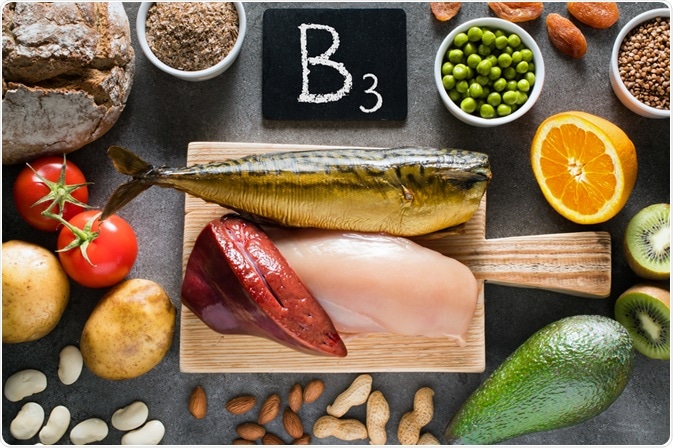Niacin is water-soluble vitamin B3 and has a myriad of important roles in humans. As excess niacin is not stored in the body, it must be ingested daily. In order to prevent niacin deficiency and secure normal functioning of the body, the dietary reference intake is 20 milligrams (mg) for both men and women.

Image Credit: Evan Lorne / Shutterstock.com
In medical practice, the usage of niacin is primarily aimed for the prophylaxis and treatment of vitamin B3 deficiency states, first and foremost of which is pellagra. However, in higher amounts, niacin is also used in the treatment of primary hyperlipidemia and cardiovascular diseases. Conventional niacin therapy has several limitations and side effects.
Flushing as the prevailing adverse reaction
Flushing induced by niacin is characterized by warmth and redness due to vasodilatation of dermal blood vessels, accompanied by a sensation of burning and tingling. This reaction typically lasts between 15 and 30 minutes. Approximately 70% of individuals who take niacin experience flushing, sometimes followed by itching and skin rashes.
Prostaglandin D2 (PGD2) plays a central role in the mechanism of flushing. Those specific prostaglandins are initially produced by bone marrow-derived cells such as platelets and Langerhans (dendritic) cells, thus contributing to subsequent induction of lipids dependent on cyclooxygenase-2 enzyme (COX-2) by dermal or epidermal cells.
Niacin-induced flushing can be reduced by pretreatment with aspirin; however, despite the fact that low doses of aspirin (81 mg/day) completely suppress PGD2 release evoked by niacin, significant residual symptoms of flushing are evident, even after pretreatment with higher doses of the drug (325 and 650 mg). These findings, therefore, raise the question of whether the occurrence of flushing is mediated entirely by prostaglandins.
The main mechanism of PGD2-mediated niacin flushing is through the D prostanoid (DP)1 receptor. Experiments on mice and humans have demonstrated that the antagonism of DP1 suppresses niacin-induced vasodilatation. For example, DP1 antagonist laropiprant (LRPT) decreases flushing induced by niacin without affecting its effects on lipids. This combination is known under the trade name Cordaptive in the United States and Tredaptive in Europe.
Other side-effects
Niacin has been known to reduce insulin sensitivity for a long time now. A proposed mechanism for this effect is the rebound increase in the levels of free fatty acids following their transient suppression induced by niacin. Still, the Coronary Drug Project (CDP) showed that the cardiovascular benefits from niacin were similar in patients with or without impaired glucose tolerance.
A condition that is akin to gastritis with symptoms such as heartburn, nausea, vomiting, indigestion, hiccups, or stomach pain can occur after niacin administration, although the exact mechanism is not clear. It can also result in hepatotoxicity that is mediated by niacin's metabolites, presenting with an increase in the serum concentration of liver transaminases. More severe reactions may manifest as jaundice or fulminant liver failure.
Niacin is known to occasionally increase plasma uric acid levels and induce gout, which is a common form of inflammatory arthritis. This may be due to the inhibitory effect of niacin on uricase, which is a copper-containing enzyme that catalyzes the oxidation of uric acid, or due to a reduction in uric acid excretion.
There is also a possibility that niacin will interact with some other medications. For example, niacin can make increase the strength of anti-hypertensives to further reduce blood pressure levels. The risk of bleeding is also increased when niacin is taken together with anticoagulants. In addition, niacin should not be taken simultaneously with the antibiotic tetracycline because it interferes with its absorption and effectiveness.
A majority of the reported adverse reactions to niacin occur with intakes between 2,000 and 6,000 mg of elemental nicotinic acid per day, in both unmodified and extended-release forms. Therefore, gram quantities of niacin should not be self-administered as a dietary supplement, but instead under the proper care and monitoring of a physician.
References
- https://www.crnusa.org/
- http://www.ncbi.nlm.nih.gov/pmc/articles/PMC3770072/
- http://atvb.ahajournals.org/content/32/3/582.long
- Kroner Z. Vitamins and Minerals. ABC-CLIO, LLC, Santa Barbara, California, 2011; pp. 227-234.
- Stargrove MB, Treasure J, McKee DL. Herb, Nutrient, and Drug Interactions: Clinical Implications and Therapeutic Strategies. Elsevier Health Sciences, 2008; pp. 281-305.
Further Reading
Last Updated: Feb 17, 2023